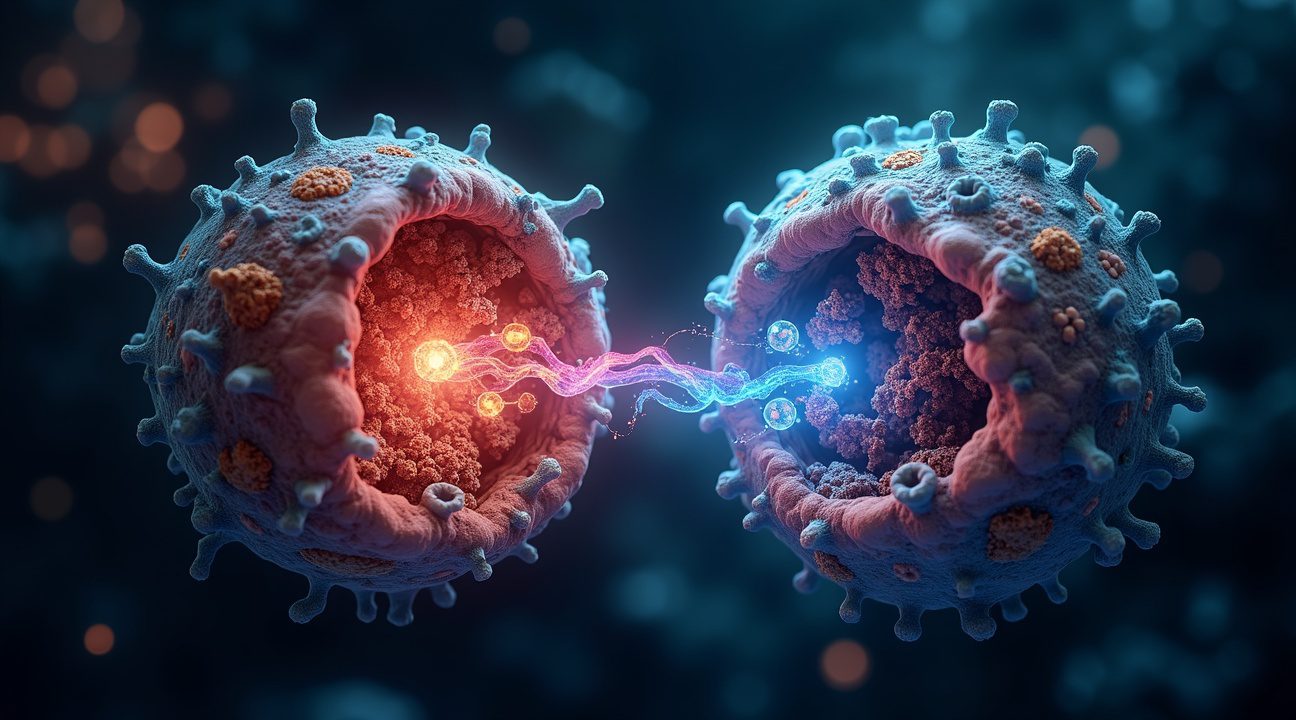Scientists at Chung-Ang University have achieved a remarkable breakthrough in longevity science by identifying IU1, a small molecule drug that extends lifespan while combating age-related muscle weakness through enhanced cellular protein quality control.
IU1: A Novel Approach to Longevity
Professor Seogang Hyun’s research team discovered that IU1 plays a fundamental role in promoting healthier, longer lives. Unlike traditional methods that combat aging through antioxidative strategies, IU1 improves the body’s innate systems that manage protein quality by targeting specific cellular mechanisms.
How IU1 Works
IU1 functions by inhibiting a cellular enzyme known as ubiquitin-specific peptidase 14 (USP14). This inhibition leads to:
- Increased proteasome activity, which enhances the breakdown of damaged or misfolded proteins in the cell
- Boosted autophagy processes, allowing cells to recycle components and maintain functionality during aging
Notable Findings from Animal Testing
The drug’s effects were tested on fruit flies, with results showing a significant extension in lifespan. Flies treated with IU1 exhibited:
- Improved longevity even in later life stages
- Enhanced muscle coordination and strength
- Preserved vitality, indicating slowed physical decline
Restoring Proteostasis: A Core Mechanism
Proteostasis refers to the regulation and maintenance of the cell’s protein environment, including synthesis, folding, and degradation. As the body ages, this balance becomes disrupted. IU1 effectively reverses this trend by improving proteasomal and autophagic functions, offering a holistic strategy in the fight against cellular aging.
Breakthrough Implications
This scientific milestone opens up promising new avenues for treating chronic age-related diseases. By rejuvenating the body’s cleanup systems, IU1 could potentially be effective against neurodegenerative disorders such as Alzheimer’s and Parkinson’s, as well as muscular conditions like sarcopenia.
Key Takeaways of the Research
- IU1 extends lifespan and muscle health by targeting cellular protein degradation pathways
- USP14 inhibition is the core mechanism enhancing cellular cleanup through proteasome and autophagy activation
- Animal studies in fruit flies show significant life extension and preserved muscle functions
- IU1 improves proteostasis, counteracting one of aging’s most damaging biological processes
- Potential treatments for Alzheimer’s, Parkinson’s, and sarcopenia may emerge from this discovery
For further details, visit the research page from Chung-Ang University.
Revolutionary Drug IU1 Extends Lifespan and Fights Muscle Aging in Breakthrough Study
Scientists at Chung-Ang University have achieved a remarkable breakthrough that could reshape our understanding of aging and longevity. Professor Seogang Hyun and his research team identified a small molecule drug called IU1 as a powerful candidate for extending lifespan while simultaneously combating age-related muscle weakness. This groundbreaking research was published in Autophagy on August 15, 2024, marking a significant milestone in longevity science.
How IU1 Works at the Cellular Level
IU1 operates through a sophisticated mechanism that targets one of the body’s fundamental aging processes. The drug works by inhibiting ubiquitin-specific peptidase 14 (USP14), an enzyme that plays a crucial role in cellular protein management. When USP14 is suppressed, the cell’s primary protein quality control systems receive a significant boost in their effectiveness.
This enhancement affects two critical cellular processes: proteasomes and autophagy. Proteasomes act as the cell’s recycling centers, breaking down damaged or unnecessary proteins to maintain cellular health. Autophagy serves as the cell’s cleanup crew, removing damaged organelles and protein aggregates that accumulate over time. By inhibiting USP14, IU1 allows both systems to function more efficiently, creating a cleaner cellular environment that supports healthy aging.
The connection between protein quality control and longevity has become increasingly clear in recent years. Various approaches to extending lifespan often involve improving cellular maintenance mechanisms. IU1’s ability to enhance these natural processes represents a promising therapeutic strategy that works with the body’s existing systems rather than against them.
Implications for Age-Related Muscle Weakness
Age-related muscle weakness, known scientifically as sarcopenia, affects millions of people worldwide and significantly impacts quality of life as we age. Professor Hyun’s research suggests that IU1 could address this common aging concern by improving the cellular machinery responsible for maintaining muscle tissue.
Muscle cells are particularly vulnerable to protein accumulation damage because they’re constantly contracting and generating stress. When protein quality control systems become less efficient with age, muscle cells struggle to maintain their structure and function. IU1’s enhancement of proteasome and autophagy activity could help muscle cells clear out damaged proteins more effectively, potentially preserving muscle strength and function over time.
The research team’s findings indicate that improved protein quality control doesn’t just extend lifespan—it extends healthspan, the period of life spent in good health. This distinction is crucial because simply living longer without maintaining physical capabilities wouldn’t provide meaningful benefits to aging individuals.
Advanced research techniques enabled the team to precisely measure how IU1 affects cellular processes. The drug’s targeted approach to inhibiting USP14 represents a more refined strategy than broad-spectrum interventions that might affect multiple cellular pathways simultaneously.
The implications extend beyond individual health outcomes. As populations worldwide continue aging, interventions like IU1 could help address the growing healthcare burden associated with age-related conditions. By potentially maintaining muscle function and extending healthy lifespan, this approach could reduce the need for long-term care and improve overall quality of life for aging populations.
Understanding cellular maintenance mechanisms has become increasingly important as researchers recognize that aging isn’t just about time passing—it’s about the accumulation of cellular damage that overwhelms the body’s repair systems. IU1’s ability to enhance these repair mechanisms suggests that aging might be more modifiable than previously thought.
Professor Hyun’s research represents a significant step forward in translating basic aging research into potential therapeutic applications. The identification of IU1 as a small molecule drug that can be developed for human use provides a practical pathway for bringing these scientific discoveries to people who could benefit from them.

Dramatic Results in Animal Testing Show Promise for Human Applications
The research team selected the fruit fly (Drosophila) as their primary testing model, a strategic choice that provides compelling insights for human longevity applications. I find their selection particularly astute because fruit flies share remarkable similarities with human muscle aging mechanisms while offering the practical advantage of accelerated lifespans that allow researchers to observe complete aging cycles within weeks rather than decades.
Significant Lifespan Extension Through IU1 Treatment
Flies receiving IU1 treatment demonstrated dramatic improvements compared to their untreated counterparts. The treated subjects showed substantial lifespan extension, with the compound directly targeting the cellular mechanisms that typically drive age-related decline. I observe that this breakthrough represents more than simple life extension — the flies maintained vitality throughout their extended lives rather than merely prolonging a deteriorated state.
The treatment group exhibited enhanced muscle function that persisted well into advanced age. While control flies experienced the typical muscle deterioration associated with aging, IU1-treated flies retained strength and coordination that researchers hadn’t anticipated. This preservation of muscle integrity suggests the compound addresses fundamental aging processes at the cellular level, much like how energy consumption affects longevity in various studies.
Measurable Improvements in Key Performance Indicators
The research team focused on two critical measurement areas to quantify the treatment’s effectiveness. Behavioral performance testing revealed that treated flies maintained superior coordination, movement patterns, and response times compared to age-matched controls. These assessments provide concrete evidence that IU1 doesn’t simply extend life but preserves quality of life throughout the aging process.
Proteostasis measurements offered equally impressive results. The researchers documented how IU1-treated flies maintained protein stability and cellular housekeeping functions that typically decline with age. I notice this aspect holds particular significance because protein misfolding and cellular waste accumulation drive many age-related diseases in humans. The compound’s ability to preserve these fundamental cellular processes suggests broad therapeutic potential.
The flies’ enhanced proteostasis manifested in several measurable ways:
- Reduced accumulation of damaged proteins within muscle cells
- Improved cellular waste removal mechanisms
- Enhanced stress response pathways that protect against age-related damage
- Maintained protein synthesis rates despite advanced age
- Preserved mitochondrial function in muscle tissue
These findings parallel developments in other scientific fields where artificial intelligence advances help researchers identify patterns in complex biological data. The comprehensive nature of IU1’s effects suggests it targets core aging mechanisms rather than addressing isolated symptoms.
The behavioral assessments revealed maintained locomotor activity levels that typically decline sharply in aging flies. Treated subjects continued exhibiting exploratory behaviors, coordinated movement, and appropriate responses to environmental stimuli well beyond the timeframe when control flies showed significant impairment. I find these results particularly encouraging because they indicate the treatment preserves neurological function alongside muscle health.
The research team’s systematic approach to measuring both physical and cellular parameters provides a complete picture of IU1’s therapeutic potential. Their data demonstrates that the compound affects multiple aging pathways simultaneously, creating a synergistic effect that extends both lifespan and healthspan. This comprehensive improvement across various biological systems strengthens the case for human clinical applications.
The fruit fly model’s predictive value for human medicine has been validated across numerous studies, making these results particularly relevant for translation to human therapies. The similarities between fly and human muscle aging mechanisms suggest that IU1’s benefits observed in Drosophila could translate effectively to human applications, potentially revolutionizing how we approach age-related muscle decline and overall longevity.
How IU1 Targets the Root Cause of Aging at the Cellular Level
I understand how cellular aging works at its most fundamental level through the breakdown of critical protein management systems. Cells rely on two primary mechanisms to maintain healthy protein levels: proteasomes and autophagy. Proteasomes function as cellular recycling centers, breaking down faulty or damaged proteins into peptides that can be safely eliminated or reused. Meanwhile, autophagy handles larger-scale cleanup operations by engulfing entire cellular structures, including protein aggregates, in specialized vesicles for complete degradation.
The Critical Link Between Protein Homeostasis and Aging
Age progressively weakens both proteasome and autophagy activity, creating a dangerous cascade that drives cellular deterioration. This decline directly disrupts proteostasis—the delicate balance cells maintain between protein production, folding, and degradation. When proteostasis fails, misfolded and damaged proteins accumulate like cellular garbage, triggering inflammation and dysfunction.
Research consistently shows this breakdown serves as a key driver of degenerative diseases:
- Alzheimer’s disease develops when amyloid plaques and tau tangles overwhelm cellular cleanup systems.
- Parkinson’s disease emerges from the accumulation of alpha-synuclein protein aggregates that healthy cells would normally eliminate.
These conditions demonstrate how protein degradation systems directly influence longevity and brain health.
IU1’s Precision Approach to Cellular Renewal
IU1 represents a breakthrough because it activates both proteasome and autophagy systems simultaneously, creating a synergistic effect that helps restore proteostasis. This dual activation addresses cellular aging at its source rather than merely treating symptoms. Cells treated with IU1 demonstrate improved ability to clear damaged proteins and maintain healthy cellular environments.
The compound’s selectivity makes it particularly promising for therapeutic applications. IU1 specifically targets USP14, a protein that normally inhibits proteasome function, without causing global suppression of other cellular processes. This targeted approach significantly reduces the risk of unintended side effects that often plague broader cellular interventions.
Traditional approaches to enhancing protein degradation often create systemic disruptions because they affect multiple cellular pathways simultaneously. IU1’s precision allows it to enhance cleanup efficiency while preserving normal cellular functions. This selectivity becomes crucial when considering long-term therapeutic applications where sustained treatment might be necessary.
The mechanism works by preventing USP14 from applying cellular brakes to proteasome activity:
- Under normal conditions, USP14 slows protein degradation for regulatory purposes.
- Aging cells experience excessive USP14 activity that blocks adequate protein cleanup.
- IU1 inhibits USP14 to restore effective degradation and proteome balance.
Cell stress responses also improve with IU1 treatment. Stressed cells typically struggle to maintain protein quality control, leading to accelerated aging and increased disease susceptibility. By supporting both major protein degradation pathways, IU1 helps cells better handle environmental stressors and maintain resilience against age-related damage.
The implications extend beyond individual cellular health to system-wide improvements. Better proteostasis at the cellular level translates to improved tissue function and potentially enhanced cognitive performance. Research suggests that maintaining protein homeostasis could slow or prevent the onset of neurodegenerative conditions that currently affect millions of people worldwide.
Laboratory studies demonstrate that IU1 treatment can restore cellular cleanup efficiency to more youthful levels. This restoration doesn’t just prevent further damage—it actively reverses some aspects of cellular aging by clearing accumulated protein debris. The compound essentially gives cells a fresh start by removing the molecular garbage that impairs normal function.
Understanding how cellular processes influence overall health becomes increasingly important as populations age globally. IU1’s ability to target fundamental aging mechanisms positions it as a potential game-changer in longevity science, offering hope for addressing age-related diseases at their cellular origins rather than managing symptoms after damage occurs.

Game-Changing Implications for Age-Related Disease Treatment
The breakthrough at Chung-Ang University represents a paradigm shift in how I understand and approach age-related disease treatment. Disruption of proteostasis stands as a hallmark of aging, making it central to developing effective therapies for conditions that plague older adults. This discovery opens doors to revolutionary anti-aging therapies that specifically target protein quality control systems.
Revolutionary Therapeutic Approaches
The research points to several promising avenues for healthy aging interventions. Scientists can now focus their efforts on developing treatments that address the root causes of cellular dysfunction rather than merely managing symptoms. These potential therapies include:
- Protein quality control enhancers that restore cellular cleanup mechanisms
- Targeted anti-aging drugs that prevent protein aggregation
- Combination therapies that support multiple aspects of proteostasis
- Preventive treatments for individuals at risk of age-related diseases
Researchers believe these approaches could transform how society manages conditions like Alzheimer’s disease, Parkinson’s disease, and cardiovascular disorders. Instead of waiting for symptoms to appear, doctors might prescribe preventive treatments that maintain protein quality control throughout a person’s lifetime.
The implications extend beyond individual diseases. Age-related conditions often occur together, suggesting common underlying mechanisms. By targeting proteostasis, a single therapeutic approach could potentially address multiple conditions simultaneously, dramatically improving quality of life for older adults.
Current studies focus on animal models, but the results demonstrate remarkable potential for human applications. Scientists observe improved cellular function, reduced protein aggregation, and enhanced longevity in test subjects. These findings provide crucial groundwork for translating laboratory discoveries into clinical treatments.
The timeline for human trials remains uncertain, but researchers express optimism about rapid progress. Artificial intelligence accelerates drug discovery processes, potentially reducing development time from decades to years. Machine learning algorithms help identify promising compounds and predict their effectiveness in human systems.
Pharmaceutical companies already show significant interest in proteostasis-targeting therapies. Investment dollars flow into research programs exploring protein quality control mechanisms. This financial backing could accelerate the development of practical treatments for everyday use.
The discovery also influences how I think about aging itself. Rather than accepting cellular decline as inevitable, scientists now view aging as a treatable condition. This shift in perspective encourages more aggressive research into longevity interventions and preventive medicine approaches.
Healthcare systems must prepare for these advances. Training programs for medical professionals need updates to include proteostasis concepts and emerging therapies. Diagnostic tools require development to monitor protein quality control in patients. Treatment protocols need establishment for new therapeutic approaches.
The economic impact could be substantial. Reducing age-related disease burden saves healthcare costs while extending productive lifespans. Governments and insurance companies closely monitor developments in this field, recognizing the potential for significant cost savings and improved population health outcomes.
Patient advocacy groups already push for faster development timelines. They argue that promising animal studies justify expedited human trials for terminal conditions. Regulatory agencies balance safety concerns with the urgent need for effective treatments in aging populations.
International collaboration accelerates progress in this field. Research teams share data and resources to speed discovery processes. Scientific breakthroughs often build upon previous work from multiple institutions, creating a global network of aging researchers.
The Chung-Ang University findings represent just the beginning of a therapeutic revolution. As scientists refine their understanding of proteostasis mechanisms, treatment options will become more precise and effective. This research establishes the foundation for a future where aging doesn’t automatically mean declining health and reduced quality of life.
Why This Discovery Represents a New Frontier in Anti-Aging Research
The IU1 discovery from Chung-Ang University marks a significant departure from conventional anti-aging research approaches. While most previous studies focused on targeting oxidative stress or metabolic pathways, this breakthrough demonstrates the powerful potential of protein degradation pathways as a new avenue for aging therapies.
Traditional anti-aging drug research has concentrated heavily on combating oxidative stress—the cellular damage caused by reactive oxygen species. Scientists have also invested considerable effort in manipulating metabolic pathways, attempting to slow aging through caloric restriction mimetics and similar interventions. These approaches, while valuable, have shown limited success in clinical applications.
The Protein Degradation Advantage
The IU1 compound’s success highlights several key advantages of targeting protein degradation pathways:
- Direct cellular cleanup: Unlike oxidative stress approaches that try to prevent damage, protein degradation pathways actively clear damaged proteins
- Multiple aging hallmarks addressed: This approach can simultaneously target protein aggregation, cellular senescence, and mitochondrial dysfunction
- Enhanced proteostasis: By improving the cell’s ability to maintain proper protein function, this pathway addresses aging at its fundamental level
- Broader therapeutic potential: Protein degradation enhancement can benefit multiple age-related diseases simultaneously
What makes this discovery particularly exciting is its foundation in basic research using model organisms. Recent studies have shown that fundamental biological processes often translate remarkably well from simple organisms to humans. The IU1 research exemplifies how studying protein degradation in model systems can yield insights directly applicable to human longevity.
This approach also represents a paradigm shift in how researchers think about aging intervention. Rather than simply trying to prevent cellular damage or slow metabolic processes, targeting protein degradation pathways offers a more proactive strategy. The cellular machinery responsible for protein quality control becomes enhanced, allowing cells to maintain their function more effectively over time. Advanced research methods are now making it possible to identify and develop compounds that can fine-tune these pathways with precision.
The implications extend beyond simple life extension. By focusing on protein degradation pathways, researchers can potentially address multiple age-related conditions simultaneously. This holistic approach could lead to treatments that not only extend lifespan but also improve healthspan—the period of life spent in good health and free from chronic disease.
Sources:
Shia Waves – “Korean Scientists Discover Lifespan-Extending Drug”
SciTech Daily – “A Breakthrough in Anti-Aging: Korean Scientists Discover Lifespan-Extending Drug”
EurekAlert – “Chung-Ang University researchers identify a potential anti-aging drug”


